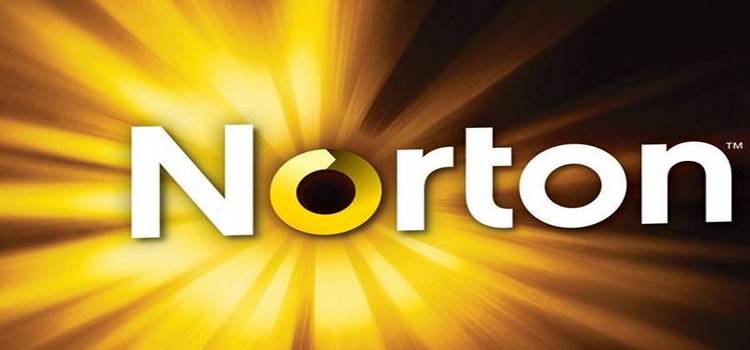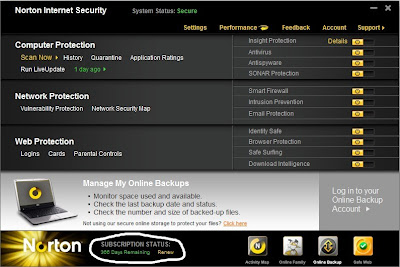Besides its Norton local security applications Symantec offers many Web-based products and services, among them online backup and parental control. A new interactive panel in its main window makes Norton Internet Security 2011 ($69.99 direct for three licenses) a manager for these online services, so you don't have to launch a browser just to check status. More importantly, however, Norton Internet Security 2011 continues a great tradition of strong antivirus and firewall protection, the central capabilities of a serious security suite.
Easy to Install and Use
From clicking "Agree & Install" to activating the fully installed product is a matter of just a couple minutes. Yes, its protection isn't at 100 percent until the first signature update, but, by default, that happens automatically when the computer is idle.
When installing to clean up an infested system you'll want to invoke that first update manually before scanning. Norton's application scan also runs during idle time, identifying known good programs on your system that don't need to be scanned. Manually invoking the application scan speeds up that first full antivirus scan significantly. On my clean test system, running a full scan before the application scan took over 45 minutes; afterward it took just over two minutes.
I frequently run into difficulties installing security products on my thirteen malware-infested test systems, but not with Norton. When one system hit a minor problem, the built-in help popped up automatically with a suggested solution; it worked.
When Norton detects an active malware threat or a network attack, it takes care of the problem and displays a small, transient popup reporting what it did. You can click for detailed information, if desired. Norton asks permission before removing a threat if it might force closure of programs you're using.
Because its protection is so low-key, you might forget Norton is even there. To make sure you know what good work it's been doing, it displays a monthly report on malware, network, and Internet threats it has blocked.
Insight-Based Protection
The top security vendors agree that new variations on viruses, Trojans, and other malware types are appearing faster than ever. Trend Micro reports that the average current threat is active for only three days, with a median lifetime of just fifteen minutes. A similar study by Symantec determined that, on average a specific malware variant infests ten computers. The median is just one computer!
Traditional antivirus signatures are still valid for identifying older, well-known threats. To combat fast-changing modern threats, Norton uses a statistical detection technique. Symantec maintains a huge database of all programs found on computers whose owners have agreed to enable "Norton Community" tracking—hundreds of millions of them.
If a program hasn't already been slotted into the known good or known bad category Norton uses this database to check the program's "reputation." Widespread programs that've been around for a while are probably safe, while rarely-seen very new programs may very well be new malware variants. Norton uses aggressive behavior-based detection to determine whether suspect programs is malicious and prevents them from doing any harm. It seems to work!
Beyond Virus Scanning
New in the 2011 edition, every scan result window includes a link to click if you think there's still a problem. This link opens the download page for Symantec's free Norton Power Eraser, an aggressive cleanup tool designed specifically to remove threats that may balk ordinary antivirus scans or prevent Norton from installing properly.
Because Norton Power Eraser is more aggressive there's a chance it might wipe out something it shouldn't. However, it won't touch files whitelisted in the big Norton Community database so any false positives will be very uncommon programs. It includes full undo capability, just in case.
Symantec also offers the Norton Bootable Recovery Tool (affectionately called NorBeRT). This tool creates a bootable rescue CD that can clean your system even when malware has rendered Windows unbootable. It's a free download, though you must enter your Norton product code to run it on a system that doesn't have Norton installed already.
Other Shared Technology
Norton Internet Security shares quite a few other features with Norton AntiVirus. For those who want to dig into system performance, both offer extremely detailed graphs showing use of system resources by Norton and by other programs. They don't display process-by-process charts the way BitDefender Total Security 2011 does, but you can point to any peak on Norton's graphs and see what caused it. New in this edition, a proactive performance warning pops up if a program hogs significant resources.
A read-only network map reveals the security status of other Norton installations on the network. The Norton Insight Network display shows realtime statistics about the Norton Community database. And the new reputation scan checks all your local programs and compares your overall stats to those of the community at large.
The interactive panel in the main window appears in Norton AntiVirus as well. To start, it displays an interactive world map of recent protection events; those who have a Norton Backup account can optionally display backup status. The suite also lets you configure it to display alerts from your OnlineFamily.Norton parental control account. If you set it show recent Norton Safe Web protection events, you can also use it to launch site lookups or safe searches. Going forward, Symantec plans to make this panel a sort of universal remote for all their Web-based services.
Intelligent Firewall
Norton's firewall hasn't changed appreciably since Norton Internet Security 2010. It handles all network-level firewall tasks, putting ports in stealth mode and preventing intrusion from the outside. As I often note, network protection is a task the built-in Windows Firewall handles quite well. Trend Micro took that fact to heart – their Trend Micro Titanium Maximum Security 2011 relies on Windows Firewall to do its job and simply adds "Firewall Booster" protection against intrusions and exploits.
Both Trend Micro and Norton eschew the old-fashioned program control feature that bombards you with popups asking whether programs should be allowed to access the Internet. They reason that known good programs don't need restrictions on their Internet access and known bad programs will be wiped out by other suite elements. Norton in particular keeps close watch on those unknowns and blocks malicious activities, including misuse of the Internet connection. Kaspersky Internet Security 2011 takes a similar view, but specifically handles unknown programs by limiting their access to sensitive areas.
Traditional program control defines which programs are allowed to access the Internet; "leak test" programs attempt to gain access without being caught by traditional program control. Norton doesn't attempt to block their access because they're just tests, with no malicious payload.
Malicious websites that attempt to reach into your system and exploit security vulnerabilities are a big problem. Even major websites can host these attacks inadvertently if they're hacked or if the attack comes in through an advertisement. Norton did a perfect job of intrusion prevention against attacks generated using the Core Impact penetration tool.
In every case, Norton displayed a small transient popup reporting a blocked attack. The history details identified many attacks by name and clearly pointed out the source website. Kaspersky also blocked all the attacks, though it identified fewer by name. Trend Micro caught and identified about half.
As always, Norton's firewall resisted all my attempts to disable it using techniques available to malware coders. In every case I got "access denied." I definitely favor the approach taken by Norton and Kaspersky. A firewall should take care of program control itself rather than quizzing users with highly technical security conundrums. I'm particularly impressed with Norton's handling of malicious exploits. Even if my system is fully patched and hence not vulnerable, I want to know when websites attack.
Here is my registered version of Norton Internet Security 2011:
So if you want to download Norton Internet Security 2011 + Activation Keys you need to click on "Download" button below and follow the Instructions.
In this archive you will find key for this program and a direct link to a free download of the Norton Internet Security 2011
How To Download:
1) On download page, Select 'Regular Download'. A survey will appear to verify that you are a human and not a bot, this is to protect the number of file downloads.
2) Simply fill in a short free survey and then download the file.
3) Once you fill the survey, the download will start, just wait for it and Save the archive to your desktop







